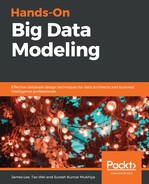In this section, we are going to discuss why we need data models, and the main benefits we can get by studying current data models. A high-level data model illustrates the core concepts and principles of any company in a very simplistic way, employing short descriptions. One of the biggest advantages of developing the high-level model is that it helps us to arrive at common terminology and definitions of the ideas and principles.
A high-level data model utilizes simplistic graphical images to illustrate the core concepts and principles of an organization and what they mean. A database model shows the logical structure of a database, including the relationships and constraints that determine how data can be stored and accessed.
Let's consider a simple student score-recording system. A student has a First name, a Last name, and a unique identifier. Each student is associated with an institution. Each student has a Start date and other data associated with them. We can better represent this using some kind of model than in a paragraph, which is difficult to understand.
Let's convert it into a model:

Now, let's consider the preceding model. It shows clearly the correlation between students and the Institution provider and how they are saved in multiple tables. It's easier to understand than a paragraph. Now let's analyze this model and see what benefits we get from the model compared with other textual representations:
- Gaining insight: A detailed model shows the process from various angles. Like in the preceding model, we can see how students are associated with the provider institutions, the different types of plans, and when a course starts. In order to start with data modeling, it is important to know the following:
- Understanding how the business works in order to understand data flow inside the organization.
- Understanding what type of data is gathered and stored in the organization.
- Understanding business processes and relationships. This knowledge guides us in building data and relationships in a data model.
- Discussion: The detailed data model can be used for discussions with the stakeholders.
- Knowledge transfer: This can be used as a source of documentation for instructing people or developers. Data modeling is a sort of documentation, both for business stakeholders and technical experts. Starting with providing a common vocabulary that different job roles can share, and by continuing on to providing newcomers with a well-thought-out business glossary, your knowledge to document and convey information about your business is greatly enhanced. In addition to this, the model can be used as a training aid.
- Verification: The process models are analyzed to find errors in systems or procedures. If your requirements gathering were complete and included the merging of data from multiple sources, as well as query and reporting obligations, you'd have business intelligence opportunities that were nonexistent when your data existed in silos, or in haphazardly-designed databases.
- Performance analysis: A detailed model made from the data can be used to analyze the performance of the system by employing several available techniques, such as simulations, and dry and run playing in the model.
- Specification: A relevant model generated from an organization's data can be utilized to create a Software Requirement Specification (SRS) document that can be used as a roadmap between a developer and end user stakeholders.
- Configuration: The models constructed from data can be applied to configure a system. A detailed model constructed with precision shows the relationship between modules and how a module can communicate with another module. This information can be used by any organization to enforce interoperability among the modules and module configuration parameters, and reduce redundancies.
